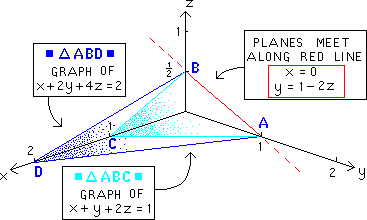|
Below is the system of equations which we will solve by G/J |
|
|
|
Below is the 1st augmented matrix :
pivot
on the"1" in the 1-1 position |
|
The one row operation for the first pivoting is
named below |
|
Next we pivot on the number
"-1" in the 2-2 position, encircled in red below |
|
|
 |
|
Below is the result of performing
P1 on the element "-1"
in the 2-2 position. Next we must perform
P2 |
|
The one row operation of
P2 is below |
|
The result of the second and last pivoting is below.
There is no 3-3 position, so the row operations of
GAUSS/JORDAN are complete |
|
 |
|
Below is a copy of the final matrix of the previous line,
with it's identity matrix in blue |
|
We now re-write each row of this matrix as an equation, just as
we wrote the original equations as a matrix |
|
A traditional style for a final solution
uses a parameter (here : z). Other variables are then written
in terms of that parameter (as below) |
|
 |
The FINAL SOLUTION above contains infinitely
many points along the (RED) line AB below.
To get a sense for what this
solution "means" Prof McFarland has drawn graphs below
of the
original equations (blue and aqua planes below) and their
red intersection :





